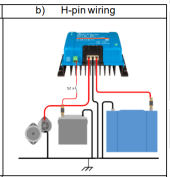StealthGTI
New Member
Hello,
I don't have a solar system, but I'm building small and in a small platform while I learn. This system could someday wind up in a van. I've been searching for answers and have watched some videos that I've found linked here. No luck yet. So, I hope this is an easy question to answer for someone.
My setup (Functional Block Diagram below):
4x 100-Ah 3.2V Fortune LiFePo4 cells for 12.8V
RadioB Tech 4S 120A BMS
Orion-Tr 12/12-30 DC-DC Charger
4-gauge OFC wire between starter battery and back of car
8-gauge OFC wire between main relay in trunk and DC-DC charger
I had the Orion-Tr in "Power Supply Mode" the first time I cycled the battery since so many hams in my club just use a power supply to charge at 14.5V. This was my first time watching a LiFePo4 battery charge while monitoring the BMS via Bluetooth app. All appeared to go well. I used "Charger Mode" the next time to see if I saw a difference. From the perspective of the BMS, battery charging went well and I had no reason to suspect a problem. However, I noticed in the Victron app that the DC-DC charger spends a LONG time in the "Absorption" phase, even long after the BMS has reported that the battery is charged and current is zero. It will eventually go into "Float" if I drive long enough.
My question: Is there a benefit to using the Orion-Tr as a "charger" if the BMS is managing the battery charging current and/or phases? Would it be better to use the charger in "Power Supply Mode" and just let the BMS manage everything? Does it even matter? Does the consumption from my connected appliances "fool" the charger into staying in float? [edit] Could it be that the BMS app does not detect or report trickle currents that may be present before the charger enters "float?" [/edit] I appreciate your comments.
Thanks,
Scott
PS: If you're curious, here is a couple photos of my setup:
Full-size

Full-size

Full-size

I don't have a solar system, but I'm building small and in a small platform while I learn. This system could someday wind up in a van. I've been searching for answers and have watched some videos that I've found linked here. No luck yet. So, I hope this is an easy question to answer for someone.
My setup (Functional Block Diagram below):
4x 100-Ah 3.2V Fortune LiFePo4 cells for 12.8V
RadioB Tech 4S 120A BMS
Orion-Tr 12/12-30 DC-DC Charger
4-gauge OFC wire between starter battery and back of car
8-gauge OFC wire between main relay in trunk and DC-DC charger
I had the Orion-Tr in "Power Supply Mode" the first time I cycled the battery since so many hams in my club just use a power supply to charge at 14.5V. This was my first time watching a LiFePo4 battery charge while monitoring the BMS via Bluetooth app. All appeared to go well. I used "Charger Mode" the next time to see if I saw a difference. From the perspective of the BMS, battery charging went well and I had no reason to suspect a problem. However, I noticed in the Victron app that the DC-DC charger spends a LONG time in the "Absorption" phase, even long after the BMS has reported that the battery is charged and current is zero. It will eventually go into "Float" if I drive long enough.
My question: Is there a benefit to using the Orion-Tr as a "charger" if the BMS is managing the battery charging current and/or phases? Would it be better to use the charger in "Power Supply Mode" and just let the BMS manage everything? Does it even matter? Does the consumption from my connected appliances "fool" the charger into staying in float? [edit] Could it be that the BMS app does not detect or report trickle currents that may be present before the charger enters "float?" [/edit] I appreciate your comments.
Thanks,
Scott
PS: If you're curious, here is a couple photos of my setup:
Full-size

Full-size

Full-size










